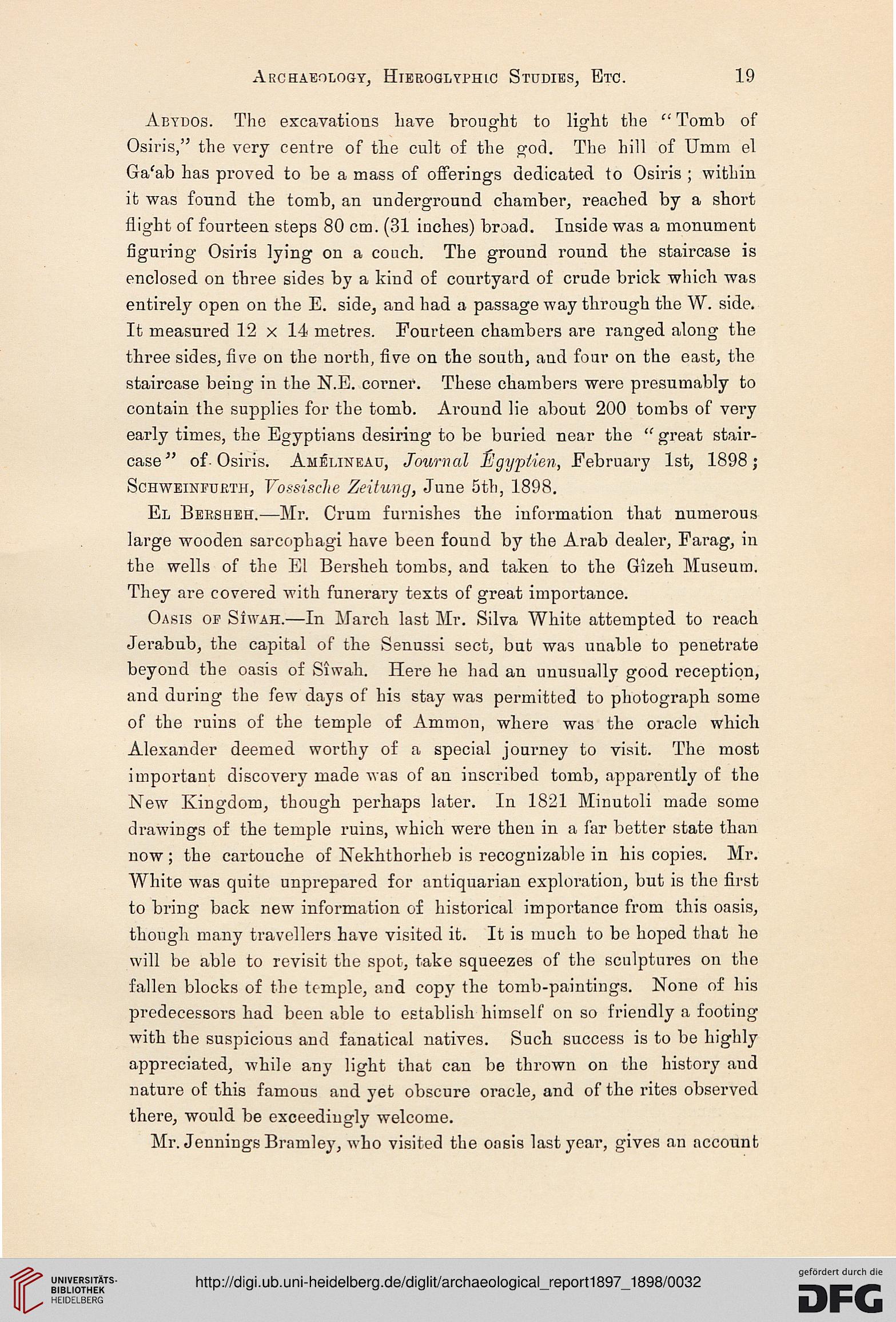Archaeology, Hieeoglyphlc Studies, Etc.
19
Abydos. The excavations have brought to light the " Tomb of
Osiris," the very centre of the cult of the god. The hill of Umm el
Ga'ab has proved to be a mass of offerings dedicated to Osiris ; within
it was found the tomb, an underground chamber, reached by a short
flight of fourteen steps 80 cm. (31 inches) broad. Inside was a monument
figuring Osiris lying on a couch. The ground round the staircase is
enclosed on three sides by a kind of courtyard of crude brick which was
entirely open on the E. side, and had a passage way through the W. side.
It measured 12 x 14 metres. Fourteen chambers are ranged along the
three sides, five on the north, five on the south, and four on the east, the
staircase being in the N.E. corner. These chambers were presumably to
contain the supplies for the tomb. Around lie about 200 tombs of very
early times, the Egyptians desiring to be buried near the " great stair-
case" of-Osiris. Amelineau, Journal Hlgypiien, February 1st, 1898;
Schweinpurth, Voasisclie Zeitung, June 5th, 1898.
El Beesheh.—Mr. Crum furnishes the information that numerous
large wooden sarcophagi have been found by the Arab dealer, Parag, in
the wells of the El Bersheh tombs, and taken to the Gizeh Museum.
They are covered with funerary texts of great importance.
Oasis op Siwah.—In March last Mr. Silva White attempted to reach
Jerabub, the capital of the Senussi sect, but was unable to penetrate
beyond tbe oasis of Siwah. Here he had an unusually good reception,
and during the few days of his stay was permitted to photograph some
of the ruins of the temple of Ammon, where was the oracle which
Alexander deemed worthy of a special journey to visit. The most
important discovery made was of an inscribed tomb, apparently of the
New Kingdom, though perhaps later. In 1821 Minutoli made some
drawings of the temple ruins, which were then in a far better state than
now ; the cartouche of Nekhthorheb is recognizable in his copies. Mr.
AVhite was quite unprepared for antiquarian exploration, but is the first
to bring back new information of historical importance from this oasis,
though many travellers have visited it. It is much to be hoped that he
will be able to revisit the spot, take squeezes of the sculptures on the
fallen blocks of the temple, and copy the tomb-paintings. None of his
predecessors had been able to establish himself on so friendly a footing
with the suspicious and fanatical natives. Such success is to be highly
appreciated, while any light that can be thrown on the history and
nature of this famous and yet obscure oracle, and of the rites observed
there, would be exceedingly welcome.
Mr. Jennings Bramley, who visited the oasis last year, gives an account
19
Abydos. The excavations have brought to light the " Tomb of
Osiris," the very centre of the cult of the god. The hill of Umm el
Ga'ab has proved to be a mass of offerings dedicated to Osiris ; within
it was found the tomb, an underground chamber, reached by a short
flight of fourteen steps 80 cm. (31 inches) broad. Inside was a monument
figuring Osiris lying on a couch. The ground round the staircase is
enclosed on three sides by a kind of courtyard of crude brick which was
entirely open on the E. side, and had a passage way through the W. side.
It measured 12 x 14 metres. Fourteen chambers are ranged along the
three sides, five on the north, five on the south, and four on the east, the
staircase being in the N.E. corner. These chambers were presumably to
contain the supplies for the tomb. Around lie about 200 tombs of very
early times, the Egyptians desiring to be buried near the " great stair-
case" of-Osiris. Amelineau, Journal Hlgypiien, February 1st, 1898;
Schweinpurth, Voasisclie Zeitung, June 5th, 1898.
El Beesheh.—Mr. Crum furnishes the information that numerous
large wooden sarcophagi have been found by the Arab dealer, Parag, in
the wells of the El Bersheh tombs, and taken to the Gizeh Museum.
They are covered with funerary texts of great importance.
Oasis op Siwah.—In March last Mr. Silva White attempted to reach
Jerabub, the capital of the Senussi sect, but was unable to penetrate
beyond tbe oasis of Siwah. Here he had an unusually good reception,
and during the few days of his stay was permitted to photograph some
of the ruins of the temple of Ammon, where was the oracle which
Alexander deemed worthy of a special journey to visit. The most
important discovery made was of an inscribed tomb, apparently of the
New Kingdom, though perhaps later. In 1821 Minutoli made some
drawings of the temple ruins, which were then in a far better state than
now ; the cartouche of Nekhthorheb is recognizable in his copies. Mr.
AVhite was quite unprepared for antiquarian exploration, but is the first
to bring back new information of historical importance from this oasis,
though many travellers have visited it. It is much to be hoped that he
will be able to revisit the spot, take squeezes of the sculptures on the
fallen blocks of the temple, and copy the tomb-paintings. None of his
predecessors had been able to establish himself on so friendly a footing
with the suspicious and fanatical natives. Such success is to be highly
appreciated, while any light that can be thrown on the history and
nature of this famous and yet obscure oracle, and of the rites observed
there, would be exceedingly welcome.
Mr. Jennings Bramley, who visited the oasis last year, gives an account





